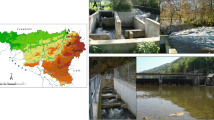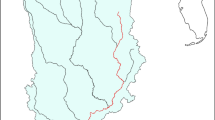Abstract
Habitat preferences and movements of the weatherfish, Misgurnus fossilis, were studied in a drainage channel of the lower River Havel region (Saxony-Anhalt) from July to November 1995. During summer, adult fish preferred dense vegetation patches (e.g. Elodea canadensis) whereas juveniles preferred the reed zones along the bank lines, characterized by coarse detritus and extremely shallow water depths (<0.1 m). All size groups totally avoided open substratum without vegetation structures. In total, 166 weatherfish ≥ 14 cm were marked individually by injected dyes and their movements were documented by recaptures (recapture rate 29%). Most of the weatherfish showed stationary behaviour or site constancy. The majority of fish (70.1%) were recaptured within ranges of 50 m with reference to the first release point. The mean movement distances slightly increased during the search for overwintering habitats in the first weeks of October. Weatherfish stocks in drainage channels of the study area are strongly affected by annual machine weeding due to depletion of suitable microhabitats and direct removal of fish. Alternative maintenance protocols for drainage channels and ditches are proposed.
Similar content being viewed by others
References cited
Balon, E.K. 1975. Reproductive guilds of fishes: a proposal and definition. J. Fish. Res. Board Can. 32: 821–864.
Bless, R., A. Lelek & A. Waterstraat. 1998. Rote Liste der in Binnengewässern lebenden Rundmäuler und Fische (Cyclostomata & Pisces). Schriftenreihe für Landschaftspflege und Naturschutz 55: 53–59.
Blohm, H.-P., D. Gaumert & M. Kämmereit. 1994. Leitfaden für dieWieder-und Neuansiedlung von Fischarten. Binnenfischerei in Niedersachsen No. 3, Hildesheim. 90 pp.
Bohl, E. 1993. Rundmäuler und Fische im Sediment. Ökologische Untersuchungen an Bachneunauge (Lampetra planeri), Schlammpeitzger (Misgurnus fossilis) und Steinbeisser (Cobitis taenia) in Bayern. Berichte der Bayrischen Landesanstalt für Wasserforschung 22, Munich. 129 pp.
Brunken, H. 1984. Die Fischfauna im Einzugsbereich des Grossen Graben in Südostniedersachsen. Braunschweiger Naturkundliche Schriften 2: 219–235.
Brunken, H. 1987. Markieren von Kleinfischarten mit Acryl-Farben am Beispiel der Bachschmerle (Noemacheilus barbatulus L.). J. Applied Ichthyol. 3: 92–96.
Brunken, H. 1988. Ausbreitungsdynamik von Noemacheilus barbatulus (Linnaeus, 1758). Ph.D. Thesis, Technical University of Braunschweig, Braunschweig. 219 pp.
Copp, G.H. 1989. The habitat diversity and fish reproductive function of floodplain ecosystems. Env. Biol. Fish. 26: 1–27.
Copp, G.H. 1992. Comparative microhabit use of cyprinid larvae and juveniles in a lotic floodplain channel. Env. Biol. Fish. 33: 181–193.
Downhower, J.F., P. Lejeune, P. Gaudin & L. Brown. 1990. Movements of the chabot (Cottus gobio) in a small stream. Pol. Arch. Hydrobiol. 37: 119–126.
Fusko, M. 1987. Zur Biologie des Schlammpeitzgers (Misgurnus fossilis L.) unter besonderer Berücksichtigung der Darmatmung. Ph.D. Thesis, University of Vienna, Vienna. 172 pp.
Gaumert, D. 1982. Gewässerunterhaltung und Fischartenschutz. Wasser & Boden 1: 19–20.
Gaumert, D. 1986. Kleinfische in Niedersachsen. Hinweise zum Artenschutz. Mitteilungen aus dem Niedersächsischen Landesamt für Wasserwirtschaft 4, Hildesheim. 71 pp.
Geldhauser, F. 1992. Die kontrollierteVermehrung des Schlammpeitzgers (Misgurnus fossilis, L.). Fischer & Teichwirt 1: 2–6.
Gollmann, H.P., E. Kainz & O. Fuchs. 1986. Zur Markierung von Fischen unter besonderer Berücksichtigung der Anwendung von Farbstoffen und Pigmenten, insbesondere von Alcianblau 8 GS. Österreichs Fischerei 39: 340–345.
Hinrichs, D. 1998. Einfluss der Gewässerunterhaltung auf die Fischfauna von Meliorationsgräben. Wasser & Boden 50(5): 22–25.
Jolly, G.M. 1965. Explicit estimates from capture-recapture data with both death and immigration-stochastic mode. Biometrika 52: 225–248.
Käfel, G. 1991. Autökologische Untersuchungen an Misgurnus fossilis im March-Thaya Mündungsgebiet. Ph.D. Thesis, University of Vienna, Vienna. 109 pp.
Knaak, J. 1960. Beitraege zur Biologie und Parasitenfauna der mitteleuropäischen Cobitiden. Ph.D. Thesis, Karl-Marx-University of Leipzig, Leipzig. 91 pp.
Laird, L.M. & B. Stott. 1978. Marking and tagging. pp. 84–100. In: T. Bagenal (ed.) Methods for Assessment of Fish Production in Fresh Waters, IBP Handbook No. 3, Blackwell Scientific Publications, Oxford.
Lelek, A. 1987. Threatened fishes of Europe. The freshwater fishes of Europe Vol. 9, Aula-Verlag, Wiesbaden. 343 pp.
Lieber, A. 1936. Der Jahreszyklus der Schilddrüse von Misgurnus fossilis L. und seine experimentelle Beeinflussbarkeit. Zeitschrift für wissenschaftliche Zoologie (Leipzig) 148: 364–400.
Lotrich, V.A. & W.H. Meredith. 1974. A technique and the effectiveness of various acrylic colors for subcutaneous marking of fish. Trans. Amer. Fish. Soc. 103: 140–142.
Penczak, T., M. Zalewski, E. Suszycka & M. Molinski. 1981. Estimation of the density, biomass and growth rate of fish populations in two small lowland rivers. Ekol. Pol. 29: 233–255.
Rolik, H. & J.M. Rembiszewski. 1987. Ryby i kragłouste (Pisces et Cyclostomata). Fauna Slodkowodna Polski 5 stwowe Wydawnictwo Naukowe, Warsaw. 314 pp.
Spillmann, C.J. 1961. Poissons d'eau douce. Faune de France 65, Editions Paul LeChevalier, Paris. 303 pp.
Sterba, G. 1958. Die Schmerlenartigen (Cobitidae). pp. 201–234. In: R. Demoll, H.N. Maier & H.H. Wundsch (ed.) Handbuch der Binnenfischerei Mitteleuropas, Vol. 3B, Instalment 9, E. Schweizerbart'sche Verlagsbuchhandlung, Stuttgart.
Vladykov, V. 1928. Ñber sekundären Geschlechtsdimorphismus bei unseren Cobitiden. Zoologische Jahrbücher, Abteilung für Systematik, Ökologie und Geographie der Tiere 55(1/3): 147–162.
Witkowski, A. 1984. Structure of communities and biomass of ichthyofauna in the Biebrza River, its old river beds and affluents. Polish Ecological Studies 10: 447–474.
Author information
Authors and Affiliations
Rights and permissions
About this article
Cite this article
Meyer, L., Hinrichs, D. Microhabitat Preferences and Movements of the Weatherfish, Misgurnus fossilis, in a Drainage Channel. Environmental Biology of Fishes 58, 297–306 (2000). https://doi.org/10.1023/A:1007681313916
Issue Date:
DOI: https://doi.org/10.1023/A:1007681313916




